I thought I’d reproduce here a talk I gave at Florida Atlantic University about a year ago. A shortened version ran in the Comics Journal, but this is the whole thing, pretty much as I presented it. It’s over 5000 words, so I’ve split it into two parts. I’ll run the second bit tomorrow. (Be warned; there are some explicit images below.)
*********************************
Comics in the Closet
I thought I’d start by reading a short, short story I wrote. This is called “Alpha Male in…Don’t Be Gay!”
*****
Alpha-Male was bitten by a radioactive penis and gained the proportional speed, strength, and emotional maturity of a penis. He lived happily out of touch with his feelings until suddenly his dick-sense tingles and, wham! The Gay Utopia arrives. A bunny offers him a flower from its anus; a burlesque troop of Hello Kitty dolls sings about bodies and pleasures; he is almost buried in pastel-colored anti-America flyers. Luckily, even the most playful subversion can’t daunt Alpha-Male! Fueled by his Alpha-testosterone, he tears several butterflies asunder and rapes a bunch of queer video projects. But for how long can our hero keep it up in a world without big box retail? Plus he can’t buy any meat so his farts don’t smell right. That’s why it’s time for the ultimate Alpha-power: mind-over-ejaculate! Desperately, courageously, he thinks of Hugh Hefner and achieves one final orgasm . Then he makes his cum take the shape of a direct-market comic store. Inside are a bunch of dudes like Frank Miller and R. Crumb making manly comics with boring layouts about fighting evil and getting laid. He decides to live there the rest of his life. Fuck the Gay Utopia! The End.
****
And here’s a couple of illustrations done for the story by Johnny Ryan, a very talented indie cartoonist who kindly collaborated with me on this:
There’s alpha male being bitten by a radioactive penis;
1and there’s alpha male using his power of mind over ejaculate to create a direct-market comic book store in which he can live out the rest of his life.
So what we’ve got in this story is a pretty clear binary, right? On the one hand, you have the gay utopia, which is feminine, frilly, and touchy feely. Then, on the other hand, you have Alpha Male, who is masculine, not frilly, and emotionally inaccessible. Most importantly, the gay utopia is gay, and Alpha Male is not.
Except that, as you can see, like all super-heroes, Alpha Male is dressed in flamboyant tights. And he’s escaping from the gay utopia into an all-male environment that is extremely sexualized. What are he and Frank Miller and R. Crumb going to do for the rest of their lives in that direct comic book store? Are they really just going to be making comics about getting laid?
So is Alpha-Male straight? Is he gay? In Epistemology of the Closet, Eve Sedgwick argues
…that many of the major nodes of thought and knowledge in twentieth century Western culture as a whole are structured — indeed fractured — by a chronic, now endemic crisis of homo/heterosexual definition, indicatively male, dating from the end of the nineteenth century.
In other words, male heterosexual identity is incoherent, built upon a binary definition of homosexual identity which is essentially untenable. Though it’s taking a few liberties with Sedgwick’s formulation, I tend to think of it like this: Heterosexual men are men who like women. But if you like women too much, then you’re feminine, and so gay. But if you don’t like women, you like men and then you’re gay. Does not compute…does not compute…boom, you blow up like one of those robots out-witted by the very manly Captain Kirk and his close, close buddy, Mr. Spock.
American comics have long been written by, aimed at, and consumed primarily by, guys. They’re basically male genre literature, like Westerns or spy thrillers, devoted to visions of mysteriously manly men performing manly deeds —flexing, fighting, rescuing damsels in distress, and so forth. Super-hero comics provide a vision of fairly stereotypical masculinity — a man is a man when he has big muscles and fights for what is right.
As a for instance, here’s a picture of Batman behaving in a typical manly fashion.
So masculinity in super-hero comics is almost laughably straightforward. And yet, at the same time, it isn’t straight at all. Instead, it’s bifurcated, incoherent and, in a lot of ways, really gay. To begin with, super-heroes generally have a secret life, a “secret identity”, that they can’t talk about even to their closest friends and relations. In other words, they are all closeted. And what’s in that closet?. A hypermasculine, muscle-bound body, swathed in day-glo tights; an uber-manly man whose physical tussles with the bad guys preclude any meaningful relationship with the leading lady. Out of costume, on the other hand, the hero is a feminized sissy-boy, whose painful secret prevents him from having any meaningful relationship with the leading lady. Either way, what looked like iconic maleness starts to look, from up close, rather queer. And that’s not even getting into the whole boy sidekick thing.
Several pictures to illustrate what we’re talking about here:
First, here’s Superman in an ambiguously compromising tussle with a bad guy.
Second here’s the Joker goosing Batman. Incidentally, this is by Grant Morrison, who is quite aware of the homosexuality of super-heroes. Alan Moore also touches on it at several points in Watchmen. I’m far from the first person to discuss this sort of thing, in other words.
Anyway, to move on: here’s Peter Parker, aka Spider-Man, canceling a date with Liz Armstrong so he can go have a secret rendezvous with the Sandman. Notice that studly Flash Thompson takes the opportunity to point out that Peter is effeminate, or as he says “Lucky for you, Liz! Now you can go out with a real man — namely me!”
I also wanted to point out here, just as an aside, that the nebbishy alter-egos like Peter Parker and Clark Kent are sometimes associated with Jewishness; most of the creators were Jewish, and you can see it as a metaphor for assimilation. This interpretation doesn’t clash with the one I’m using, I don’t think — Jewish maleness and gayness are often associated with one another, both being grouped together as unmanly. Sedgwick I think would argue that the heterosexual/homosexual binary shapes the way we deal with issues like ethnicity and assimilation, which is why we have the stereotype of the Jewish nebbish in the first place.
Anyway, on to boy sidekicks: here’s Bruce Wayne (Batman) in bed with his youthful ward, Dick Grayson. Apparently when the unhealthy sexuality of comics was being condemned in the 50s, this panel served as an important case in point.
And here’s a multiple boy sidekick panel; Bucky, who’s Captain America’s partner, is grinning lasciviously and saying “Did you see the way Robin kept looking at me, Cap? I guess he knows who’s got the better partner…and the more exciting life!”
And one more boy sidekick image, because I couldn’t help myself.
Sedgwick incidentally points out that one of the main uses of the closet, perhaps for those inside, but definitely for those outside, is the way it allows one to feel smart and knowledgeable. You look at these images in this context and you say, hey, I know something here that most people, maybe even the creators, don’t. In this case, though, knowledge isn’t so much power as it is participation in mechanisms of pleasure. Enjoying your knowledge is one of the ways that the closet has power over you, not the other way around.
So, besides a desire to feel that I’m especially clever, why point this stuff out? Well, one reason is that the fractured masculinity we’re talking about here has some important effects on the way men are presented in these comics. In her books, Sedgwick argues that anxiety about homosexuality, or homosexual panic, is a trait *not* of gay men, but of *straight* men. If you’re gay and all the way out, you don’t need to worry about the closet, because you don’t have to worry whether people think you’re masculine enough. Straight men, on the other hand, have to always keep one hand on their masculinity (so to speak.) This can be expressed very dramatically, thorough, for example, homophobia or gay bashing. But it can work in more subtle ways as well.
One of the things Sedgwick talks about in this context is the idea of sentimentality. She points out that the sentimental is typically defined in terms of insincerity and femininity. It tends to be connected to genre fiction for women (romance novels, Hollywood romantic comedies) or else to a camp aesthetic associated with gayness (musicals, Joan Crawford melodramas.)
However, the fact is that sentimentality is just as much a male mode as a female one. It’s just that, where sentimentality in romance tends to be focused on tragic relationships, in male genres the sentimentality is tied up with the crisis of masculine identity which we’ve been talking about. Specifically, men are figured as stoic, and anti-sentimental. The male sentimental mode is all about men’s lack of sentimentality —the tragedy of the man who would cry, but will not, or cannot.
Sedgwick links this cultural fact to “an extraordinarily high level of self-pity in non-gay men” in the U.S., and argues that such “straight male self-pity is…associated with, or appealed to in justification of acts of violence, especially against women.” This is one typical justification for domestic abuse, for example — the idea that the woman emasculated, or made the man feel bad about himself, and therefore he is tragically driven to beat her up. You also see this in murder ballads, where the protagonist, as Hendrix puts it, is always “going to shoot my old lady/caught her messin’ round with another man.”
This link between maleness, self-pity, and violence, is readily apparent in American comics. Though on the surface super-hero stories seem to deal with very masculine subjects like law-and-order and fist fights, when you look a little deeper its clear that comic-books are sodden with masculine self-pity and sentimentality. This soppy maleness is, in fact, the main tool of identification, of plot, and of character development. Superman, Batman, and Spider-Man, the three most iconic examples of the genre, are orphans, and it is their status as such which impels, justifies, and lubricates their masculine physiques, skin-tight attire, and repetitive fisticuffs.
As a particularly clear example, of what I’m talking about, here’s a page from an early 80s Daredevil story, in which they’re retelling his origin. Daredevil’s Dad, Jack Murdock, is a prizefighter, and he’s being threatened if he doesn’t throw the fight. But inspired by his love for his son, and, one suspects, by his investment in his own masculinity, he refuses to lie down, and in an orgasmic surge of violence and sentiment, defeats his opponent.
For not throwing the fight, Jack is killed, which, naturally, inspires his son Matt Murdock, not to cry, but to don yellow tights and unleash an orgy of violence of his own.
And here’s Daredevil, not crying, but threatening.
As you can see, love between men is expressed not through tears or affection, but through bellowing and bashing.
Other characters of the Marvel stable have their bifurcated difference as the cause of their sentimental histrionics; their status as closeted or outed other is their tragedy, and, again, their excuse. This is the case for the Hulk, a semi-nude, muscle-bound id who gets to express his emotions by bashing everything in sight — but it’s all morally okay because when he turns back into snivelling, skinny Bruce Banner, he whines about it. The Thing works in a similar way. My son is currently obsessed with this one old cartoon where the Thing changes into human form and decides to go get married; before he can, though, he’s changed back into his orange rocky self by Dr. Doom — and this provides the occasion, not for tears, but for him to go on a murderous rampage in which he almost kills the bad guy. And then there’s the storyline in which the Thing and the Hulk switch bodies. Here’s a picture of the Thing trussed up and willing, as the shirtless and oddly ripped Bruce Banner explains the pseudo-science whereby their intimate attachment is going to save both of them from their hyper-masculine selves.
I don’t know if you can read the text here, but The Thing tells Banner, “Ya ain’t got any idea how long I’ve been waitin’ for somebody ta say that. If I didn’t think ya’d get the wrong idea, I could kiss ya!”
Of course, they don’t actually kiss each other; instead the experiment goes wrong, the two switch minds, and then they spend the rest of the comic working off the repressed sentiment by assiduously whacking at each other.
_________________
Part 2 tomorrow, where we extend the argument to Cerebus, Jimmy Corrigan, and shojo.
Update: Part 2 is here.


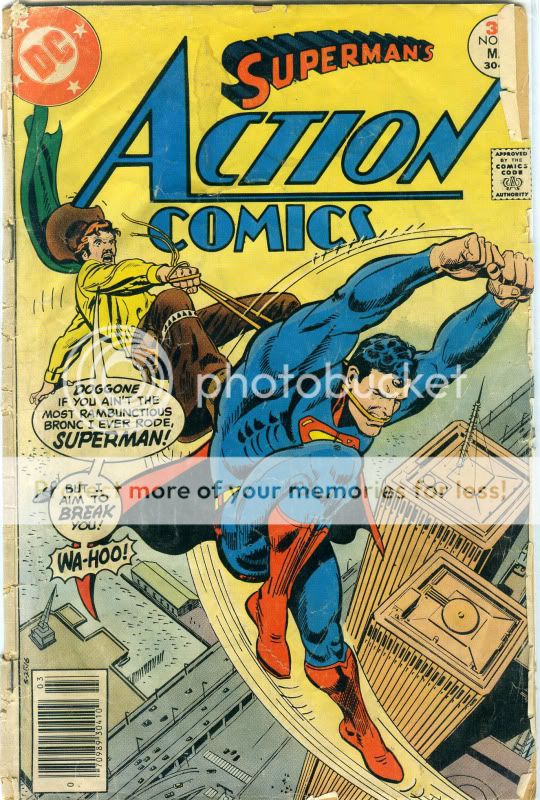
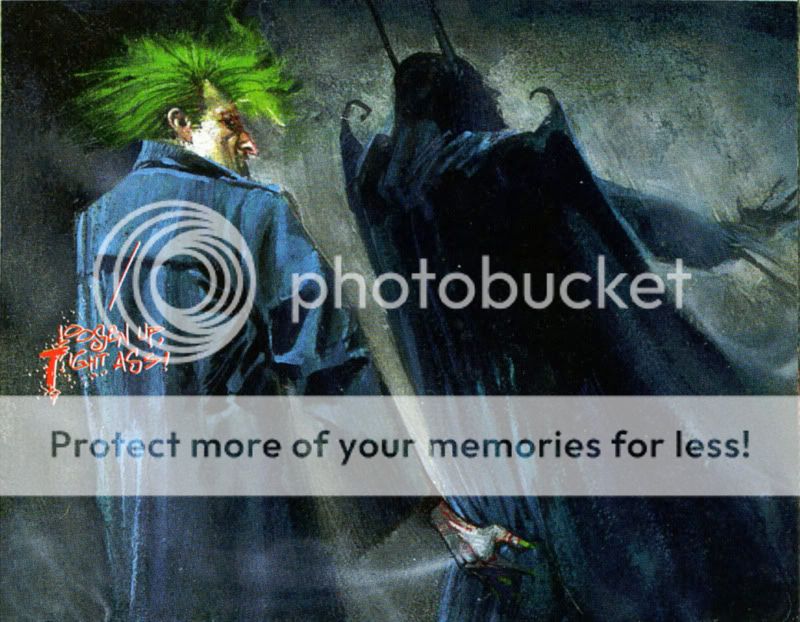
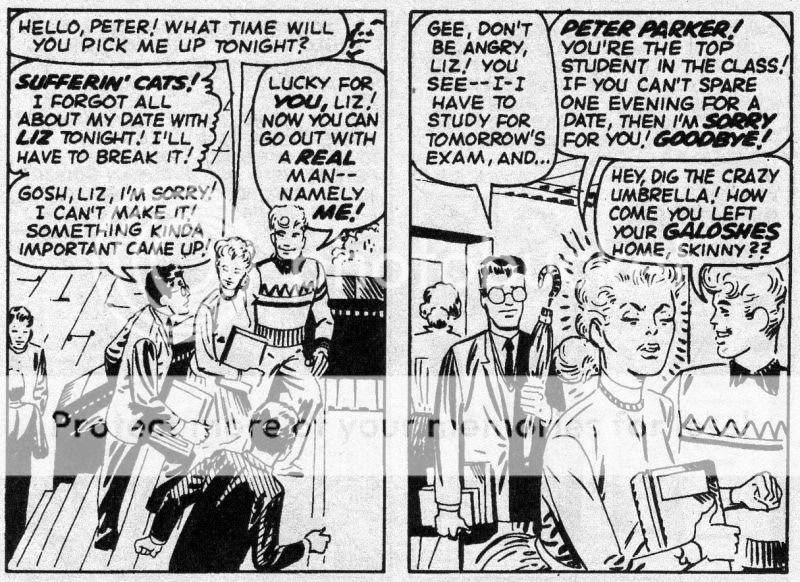

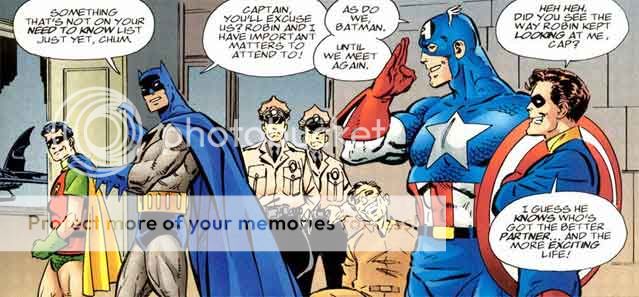
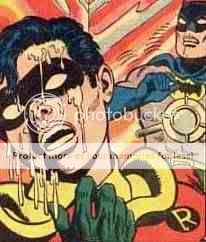


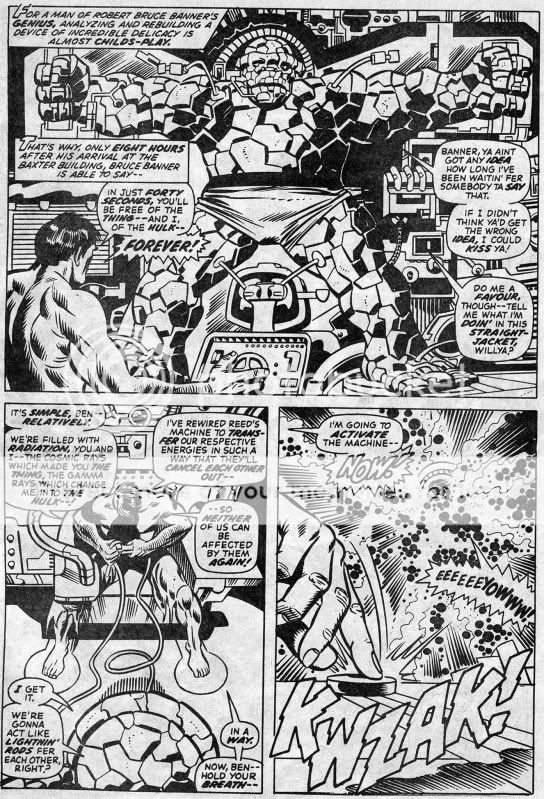
I'm MOSTLY with you, but a few of these examples seem almost the opposite of what you're saying:
The Kirby Hulk/Thing bit seems, t'me, like a joke rooted in casual homophobia – Masculine guys kissing. What an absurd idea. How funny.
And some of it is simple math. You draw a certain number of panels, some of 'em are gonna come out looking like Robin with jizz on his face. Lord knows how many times I've set out to draw… say, a watermelon and a sailboat and it comes out looking like Robin with jizz on his face.
BUT maybe I've said too much….
"The Kirby Hulk/Thing bit seems, t'me, like a joke rooted in casual homophobia"
I don't think there's a contradiction there at all. It's standard frat boy dynamics; casual homophobia is a tried and true form of male bonding; you make a gay joke to show that you're expression of affection doesn't make you gay. There's a similar dynamic in rap, which is obsessed with/in love with/ terrified of expressions of male bonds.
Or look at it this way; the writers wanted to convey that the Thing is deeply grateful to Banner. They can't have them actually kiss (that would be wrong and weird.) So they make a joke out of it, which expresses both the desire and the anxiety.
The Robin jizz thing is obviously gratuitous, as I said. At the same time…there's Batman in the background. I think it's funny in part because it's so obvious.
Maybe this is something you're getting to tomorrow, but I'm curious as to how expressions/fears of male relationships in the 20th century are different from those in the 19th century. Are there substantial differences, and if so, what brought about those changes? Does Sedgwick talk about that at all?
Sedgwick is more interested in the 19th century in her examples in Between Men, for instance, because she was initially a 19th century scholar. She does bring the whole thing into the 20th century in Epistemology of the Closet, however. There are some differences (and I'm not as familiar with her later work after Epistemology)–but the basic argument holds up pretty well even today–maybe with a bit more irony and self-conscious deflection in popular representations of masculinity. Aren't Judd Apatow's "bromance" comedies just a winking version of this?
And…the Hulk/Thing thing fits perfectly into Sedgwick's argument. She basically says homophobia is a way for engage in "homosocial" relationships without admitting their homoerotic nature.
Sports are a classic example… All men naked in a locker room taking a shower. They cement and deny their homosocial/homoerotic relationship(s) by making gay jokes (and mistreating anyone who may smack of gayness). Right or wrong (and I buy most of the Sedgwick argument), the Thing/Hulk thing holds no problems for the Sedgwick line of argumentation.
It's a good question, Richard. I actually went looking for my copy of Between Men, without success. To the best of my memory, though, Eric's right; she makes some gestures at historicizing the dynamic she discusses, but it's not her main area of interest. She's more interested in working through individual examples and discussing their differences rather than looking at historical periods. I agree with Eric, too, that the dynamic she describes seems very much still present, in lots of genres.
Hey, thanks for the quick responses!
Wow… So you needed five thousand words to take Scipio from The Absorbascon's favorite running gag and drain what little humor there is left in it right out of it?
If that was your goal, good job. I guess.
Bloggers have been exploiting this idea for cheap laughs for at least ten years.
In other news, water contains hydrogen and the swine flu can result in taking time off from work.
Come back, Tom Crippen! You're this site's only hope!
Fuck you, Brian…but in a loving way.
Brian T.–
I haven't read everything NB has written, but preferring TC to him seems unjust.
If NB has written anything as abominable as TC's review of MEN OF TOMORROW, you'll have to recommend it to me. This essay is riddled with bad logic, all right, but the MOT review was, to quote Lovecraft, "a thing of unutterable ghastliness."
An advance FYT to whomever.
Hey Gene. That's Tom's "Big Dumb Dream" essay, right? That's a great essay. I'm sure he'd be pleased to know it's still sticking in your craw.
I've got an essay in some forthcoming TCJ about Shuster's fetish comics which I suspect will really annoy you…probably not as much as Tom's essay did, but I do live in hope.
I haven't read the second part of this, but I find it fascinating and well-written. I guess Noah's style of writing and analysis here hits me right in the sweet spot, as it were.
However, I'm mystified by why guys like Brian and Gene show up, read these whole things, and then comment about how they don't like them. Just don't read it or visit the site, dudes. It's not that hard. Hell, I knew better than to bother visiting Gene's site after trying to muddle through his nonsensical defense of superhero decadence. Brian's even dropping comments over at Tucker's site about how he dislikes Noah. What, did he come and piss in your corn flakes or something? Such bizarre behavior; man, the internet is weird.
Gene makes sense; he wants to use it as a point for jumping off; probably saw a link from journalista, figured, oooh, I hate that sort of thing, read it, then scurried back to his blog to write about how he hates that sort of thing. Fair enough…I've been there.
Brian I don't get. Maybe it's similar to the way I occasionally listen to NPR even though it irritates me? I guess he could be here for the traffic and weather….
Anyway, glad you liked it Matthew.
Noah, I'm sure you'll reach Tom's level of cockblocked logic if you keep on trying.
I'd suggest leaving out all the intellectual discourse you have in this essay to start, since "Big Dumb Dream" had none.
Heh heh.
He said "cockblocked."
It's simple, really. I'm a disgruntled fan. I got several months' worth of great free entertainment out of this site, but now…
I'm definitely at the "your old stuff was better" phase.
I hate pretty much everything the contributors are doing lately. But I kept hanging around hoping the team would turn around their losing season (to use a bad sports metaphor).
I read this article because, well, I wanted to see if A.) it would make more sense to me than that "dick and fanny" stuff Berlatsky wrote a while back and B.) what Berlatsky would do with a topic that's been done to death by Superman is a Dick, The Absorbascon, Comics Make No Sense and a bunch of other blogs and humor sites.
I wanted to be won over and be a fan again. Surely, you've bought a comic you have mixed feelings about in the hope that it would get better before? What's so hard to understand about that?
Anyway… I think I'm finally at the point where I'll be happier if I just stop reading Berlatsky's stuff.
Especially after that totally unnecessary blowjob panel in part two. I think I'm obligated to boycott this site for religious reasons on top of everything else.
I can deal with pretentious and douchey. In small doses, anyway. I can deal with things that challenge my moral code. But when you're doing all three at once, then it's time for me to leave.
Gene, much as I enjoy this nerdtosterone fueled foreplay, I thought maybe I'd try another tack.
Have you read Carl Wilson's "Let's Talk About Love: A Journey to the End of Taste," about his effort to appreciate Celine Dion? It seems like you might enjoy it; he's definitely a pluralist in your terms, I think (a popist in his.) I quite liked it, with some reservations.
I also wonder what you think about the Left Behind series, which is obviously populist genre literature in some sense. (I haven't read those books myself, but I'm kind of curious to give them a try at some point.)
Wait, so was Dick and Fanny the older, better stuff, or the point where it all went downhill? Because that was quite a while ago, wasn't it?
And this is definitely a much deeper reading than the usual "ha ha, Batman is gay!" stuff you see around the web. I mean, I can make sense of it, and I'm not exactly a paragon of intellectual discourse.
I can understand the impulse to hope something you once liked gets better though, but I don't see how Noah (and pals) have gone downhill. This is pretty much the same thing he's always been writing, isn't it? I mean, we can always hope for more contrarian arguing against sacred cows like Art Spiegelman and 100 Bullets, but Noah's been writing about gender and shit for years. The Gay Utopia stuff he mentions was from a few years ago wasn't it? Wait, was that the turning point? And you're still reading along several years later, hoping it'll get better? You're like the X-Men fan of the blogosphere! Noah, you should be proud!
Okay, I should shut up before I become too much of a jerk in the manner which I am decrying. Sorry if I offended (not really).
Hey Brian. That makes sense. I'm sorry you're not enjoying the blog anymore, but certainly agree that it's not worth following if it's irritating you. In any case, take care.
Whoops! You got in before me Matthew.
I've been doing comics and gender stuff for a good long while. The Gay Utopia was actually just a little less than a year ago, now, but I was certainly talking about this sort of thing before then.
This essay itself is actually from a year ago, as I said. I've actually been doing less with Sedgwick and gay theory, though I've still been writing about gender and sexuality with the WW posts.
I presume Brian wants more attacks on art comics folks like Chris Ware and Jeff Brown — I think he may be Dumas from the comicon message board actually? If not, he seems to be coming from a similar place. Either way, I have sort of backed off on sneering at Ware, et al., largely because…well, I don't like reading their comics. I explained why a few times, and then I just went on to reading things I do like (like Marston/Peter.)
More explanation than anyone is really interested in, probably. But such are blogs.
I don't think it's any great secret that fighting, in superhero comics especially, is more often than not sublimated fucking, especially once the '70s Marvel ethic took hold and fights happened absent of any motivation but two characters looking at each other. The "frat boy" thing is right, on the surface the concept is "I'm so confident in my sexuality I can joke about being homosexuality" but I've never known a frat boy who commonly made that sort of comment (and a lot of frat boys don't) who didn't have underneath it a streak of homophobia that wasn't, sometimes obsessively, based on terrified bi-curiosity.
Where things really get interesting for comics (on the subject) is when the original "Image artstyle" comes into mad vogue in the late '80s, and all the artists talk endlessly about Jack Kirby as their major influence when their figurework most closely resembles Tom Of Finland's. And the fights REALLY got out of hand.
By the way, the Hulk-Thing joke isn't that two really masculine guys might kiss, it's that two really masculine monsters might kiss. And the funniest thing about that hentai Robin cover isn't that Batman's there, but that rather than taking part he's obviously watching from behind plate glass, like in a Times Square peep show…
Hey Steven. Always nice to have you stop by.
That Image art/Tom of Finland connection is *hysterical*. I never thought of that, but it's obvious when you say it.
I think both Hulk and Thing are monsters because/as part of being hyper-masculinized. Thus the names….
Steven Grant:
"And the funniest thing about that hentai Robin cover isn't that Batman's there, but that rather than taking part he's obviously watching from behind plate glass, like in a Times Square peep show…"
I wish you guys would get your BS Freudian readings straight.
How can Batman be corning the Boy Wonder (as I assumed NB meant to imply) if there's a plate of glass between them?
And DON'T say that with enough time to prepare, Batman can do anything.
Noah, I've no idea why the LEFT BEHIND series would strike you as relevant, unless there's another Freudian setup in the title…
The Left Behind series is interesting to me in the context of your interest in pluralism. It's pulp genre fiction which is largely despised by elites; I thought you might have something interesting to say about it — do you think it's worthwhile? Are you willing to defend it? How would you go about it? I'm not trying to trap you; in pluralistic fashion, I'm just interested in what you'd have to say about it, if anything.
Steven and I don't need to get our readings straight, as it were — I said one thing, Steven said another. It's a discussion, not an exercise in one-upmanship. As it happens,though, I think his reading is (a) funnier and (b) works better with the text. So if we must resolve it, we can just do so by saying that he's right.
Noah,
If you're interested in the Left Behind series, the Slackivist has been doing a close read of them for years. It's quite interesting.
http://slacktivist.typepad.com/slacktivist/
As for the essay itself, I found it interesting, but I'm going to think about it some more before I have anything useful to say.
Gene: I was correcting Noah's interpretation of the Batman cover. Clearly some off-screen party has treated Robin to a bukkaki (sorry if I botched the spelling on that) bath. Batman is only the voyeur. (Batman has his pants up in any case, making his direct involvement unlikely.)
And it's not a Freudian reading. We're responding to the imagery as drawn, though undoubtedly Carmine, Sid and Julie didn't view the picture in a sexual context and I don't think anyone is suggesting they did. But the image isn't exactly a Rorschach test, or abstract art, and in a modern context it's NON-sexual content that would need to be interpreted, since the sexual content would, in the absence of other information, appear obvious.
Noah: Tom of Finland. Beautiful, muscular male and female heroes are THE staple of superhero comics – the staple of western pop culture, really – but it's only since the late '80s that superhero physiology has been totally fetishized. And the prototype of that kind of fetishism is Tom Of Finland. Some work of Image artists and their knockoffs at all comics companies were physically so close to the Tom Of Finland work I'm certain at least some of them were swiping him, but no one has ever copped to it that I'm aware of.
And certainly the Hulk and the Thing are "monsters" due to being hyper-masculinized. No disagreement there. But not as hyper-masculinized as Giant-Sized Man-Thing. (Sorry, couldn't help it.)
Steven said:
"And it's not a Freudian reading. We're responding to the imagery as drawn, though undoubtedly Carmine, Sid and Julie didn't view the picture in a sexual context and I don't think anyone is suggesting they did. But the image isn't exactly a Rorschach test, or abstract art, and in a modern context it's NON-sexual content that would need to be interpreted, since the sexual content would, in the absence of other information, appear obvious."
It's a Freudian reading not in terms of doctrine but in terms of methodology: you want to find sexual imagery in any juxtaposition of Batman and Robin, so you find it. It's not a Rorschach test, true, but that's because you've already decided in advance what you're going to see: you and Noah merely differ on the details.
Can either of you, for instance, honestly say that Batman's expression looks sexually excited? If so, you must have had some real stone-faced partners in your time.
Some silly associational humor is valid. In a much-reproduced JLA panel, where some heroes are worrying about their girlfriends while Batman's worried about Robin, the humor is logical given gay readings of B & R, even though said reading is obviously nothing that the original creators intended.
But this one's just silly, period.
But aren't you doing a Freudian reading of our motivations. You say we "want" to find sexual imagery. Your attributing unacknowledged motivations. By your own broad definition, that's a Freudian reading, yes? Along those lines, we could of course turn it around and start questioning your motivations (why is it so important to you that there is *not* sexual imagery there? What is it about homosexuality as a critical lens that you find so off-putting? Why are these struggles for intellectual one-upmanship so irresistible to you? etc. etc.)
But perhaps instead of delving into such murky waters, we can just agree to disagree.
And honestly, the Robin panel was more a joke than evidence per se, as I indicated in the text. If you don't find it funny, that's fine. I thought your post on bestiality/masochism/etc. in comics covers was fairly entertaining myself, but perhaps my sense of humor is just more Catholic, at least in this instance.
Vom, thanks for the Left Behind link by the way. It's more or less what I thought analyst's response to the book would be — more or less outright attack. I don't think they don't deserve that, but I guess I was wondering if Gene, who (I think) really dislikes moral attacks on genre literature, might want, from that perspective, to defending them. He seems pretty clearly uninterested, though. So it goes.